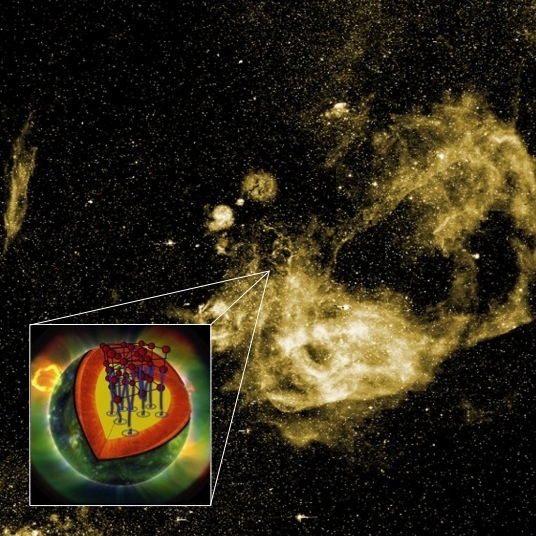
The background shows the Vela supernova remnant at optical wavelengths with location of the Vela pulsar indicated. Inset: Artist’s impression of the pulsar’s interior, and the interaction between superfluid vortices and the nuclei that make up the star’s crust. Credit: CTIO/AURA/NSF
Using a mathematical model, in conjunction with data from radio telescopes and recent results from nuclear physics theory, researchers at the University of Southampton challenge a 40-year-old theory explaining the ‘glitching’ of pulsars in their newly published study.
Researchers from the University of Southampton have called into question a 40-year-old theory explaining the periodic speeding up or ‘glitching’ of pulsars.
A pulsar is a highly magnetized rotating neutron star formed from the remains of a supernova. It emits a rotating beam of electromagnetic radiation, which can be detected by powerful telescopes when it sweeps past the Earth, rather like observing the beam of a lighthouse from a ship at sea.
Pulsars rotate at extremely stable speeds, but occasionally they speed up in brief events described as ‘glitches’ or ‘spin-ups’. The prevailing theory is that these events arise as a rapidly spinning superfluid within the star transfers rotational energy to the star’s crust, the component that is tracked by observations. However, Southampton academics have used a mathematical model to disprove this.
Professor Nils Andersson explains: “Imagine the pulsar as a bowl of soup, with the bowl spinning at one speed and the soup spinning faster. Friction between the surface of the bowl and its contents, the soup, will cause the bowl to speed up. The more soup there is, the faster the bowl will be made to rotate.
“This analogy describes the concept behind the accepted theory of why pulsars suddenly increase speed or ‘spin-up’. However, our research shows that these pulsar glitches are too large to be explained in this way. The amount of superfluid, or ‘soup’, available in the crust of a pulsar is too small to cause the kind of friction needed to create this effect.”
Professor Andersson and Dr. Wynn Ho from the University of Southampton used their calculations, in conjunction with data from radio telescopes and recent results from nuclear physics theory, to challenge current thinking on this subject.
The Southampton researchers have written a paper detailing their theory, produced in collaboration with Kostas Glampedakis at the Universidad de Murcia, Spain and Cristobal Espinoza at the University of Manchester. It is published in Physical Review Letters.
Reference: “Crustal Entrainment and Pulsar Glitches” by N. Chamel, 2 January 2013, Physical Review Letters.
DOI: 10.1103/PhysRevLett.110.011101









When super galaxies are travelling in the universe at a fantastic speed, propelled by Dark Matter found, 96% , along with Dark Energy ,in the Universe, to result in the expansion of the Universe , why can’t these Pulsars also subject to Dark Matter Forces on their transit in the cosmos? Thus the periodic glitches of Pulsars can be possible by this method just like Gravitational lensing of distant galaxies by Dark Matter. After all rotating electro-magnetic radiation is simply an extension of light in the spectrum, isn’t it? Thank You.